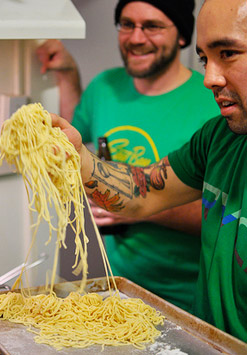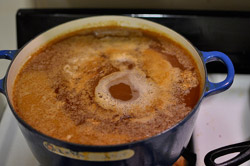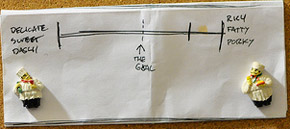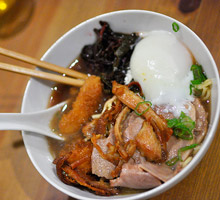Not Your Dorm Room Ramen
June 11, 2010
 Richie Nakano had been experimenting with homemade ramen for a few years when he decided to travel to New York for a tour of the city’s ramen hotspots. After slurping, tasting, and biting into tangles of house-made noodles in places like Ippudo and Ramen Setagaya, his curiosity had been transformed into a plan. When he returned to San Francisco, he decided, he would use all homemade, locally sourced ingredients to create a bowl of ramen all his own.
Richie Nakano had been experimenting with homemade ramen for a few years when he decided to travel to New York for a tour of the city’s ramen hotspots. After slurping, tasting, and biting into tangles of house-made noodles in places like Ippudo and Ramen Setagaya, his curiosity had been transformed into a plan. When he returned to San Francisco, he decided, he would use all homemade, locally sourced ingredients to create a bowl of ramen all his own.
“When I’d ask people if they were into ramen, they’d say ‘no, not since college,’” he recalls. “But that gives us a unique opportunity to expose people to something new.”
Nakano, who was the sous chef at NOPA at the time, joined forces with Kitty Gallisa, a bartender at NOPA, to form Hapa Ramen. For the last year, the business partners have developed Hapa (as a pop-up) on top of their jobs at the restaurant; this month Nakano is leaving NOPA to make Ramen full time. Their new booth (which will appear next Thursday, June 17) at the Thursday Ferry Plaza Farmers Market is central to their plan, along with a yet-to-be-determined regular pop-up venue.
Nakano, who is part Japanese and has family from Hawaii, likes the way the Hawaiian word “Hapa” sums up his goal with the project. Generally used to mean “of mixed race” in the islands, Nakano says it also reflects his interest in combining traditional Asian techniques with modern Western ones.
Stocking Up
 Nakano has worked meticulously to perfect the stock at the base of his ramen. Each batch starts off with dashi, a traditional Japanese soup base, made with kombu seaweed he sources from Tomales Bay. Then he’ll add some combination of pork bones (from Becker Lane or Long and Bailey), chicken (from a co-op in the Central Valley), and a variety of aromatics. He’ll simmer it all on a very low heat for as long as 72 hours.
Nakano has worked meticulously to perfect the stock at the base of his ramen. Each batch starts off with dashi, a traditional Japanese soup base, made with kombu seaweed he sources from Tomales Bay. Then he’ll add some combination of pork bones (from Becker Lane or Long and Bailey), chicken (from a co-op in the Central Valley), and a variety of aromatics. He’ll simmer it all on a very low heat for as long as 72 hours.
“To dial it in and get it really tight I’d cook it every week and take ridiculously detailed notes about everything,” he says (see image below). “It would drive my wife crazy. The whole house would smell like stock. When we moved out the stove was destroyed.”
 And yet, says Nakano, there’s really no more rewarding feeling than going to sample a stock you’ve cooked for days and having it taste exactly like you hoped it would. “And there’s also nothing more crushing than having it taste terrible,” he adds. “You can over-reduce it or thin it down too much and destroy the gelatin balance. Or you can overdo aromatics like dried mushrooms. And — if you add too much chicken — it just tastes like chicken soup.”
And yet, says Nakano, there’s really no more rewarding feeling than going to sample a stock you’ve cooked for days and having it taste exactly like you hoped it would. “And there’s also nothing more crushing than having it taste terrible,” he adds. “You can over-reduce it or thin it down too much and destroy the gelatin balance. Or you can overdo aromatics like dried mushrooms. And — if you add too much chicken — it just tastes like chicken soup.”
Not that ramen ends with stock; Nakano also makes his noodles from scratch, and adds poached eggs from Marin Sun Farms and seasonal vegetables from a variety of local farms. This month’s soup has included English peas from Iacopi Farm, snap peas from Catalán Family Farm, and chard from Dirty Girl Produce. “We’re looking forward to getting corn in there next,” he says. “And maybe roasted summer squash.”
Clear as Broth
 Nakano is happy to talk about everything he adds to his ramen. “We want to take away the mystery,” he says. “A lot of chefs treat their broth like a closely guarded secret. We want to take the opposite approach and share everything with everyone…recipes, techniques, ideas.” For instance, Nakano has been exchanging ideas with Namu’s Dennis Lee, who serves his own version of the soup.
Nakano is happy to talk about everything he adds to his ramen. “We want to take away the mystery,” he says. “A lot of chefs treat their broth like a closely guarded secret. We want to take the opposite approach and share everything with everyone…recipes, techniques, ideas.” For instance, Nakano has been exchanging ideas with Namu’s Dennis Lee, who serves his own version of the soup.
“I think everyone should get to know how to make this stuff. And everything, for that matter. If someone spends 72 hours in their own kitchen and comes away with something amazing, I’ll benefit from it.”
Hapa Ramen’s first day in the market will be Thursday, June 17. Photos of Richie Nakano and his stock by Jesse Friedman of Beer & Nosh.
Topics: Chef, Food makers, Local
